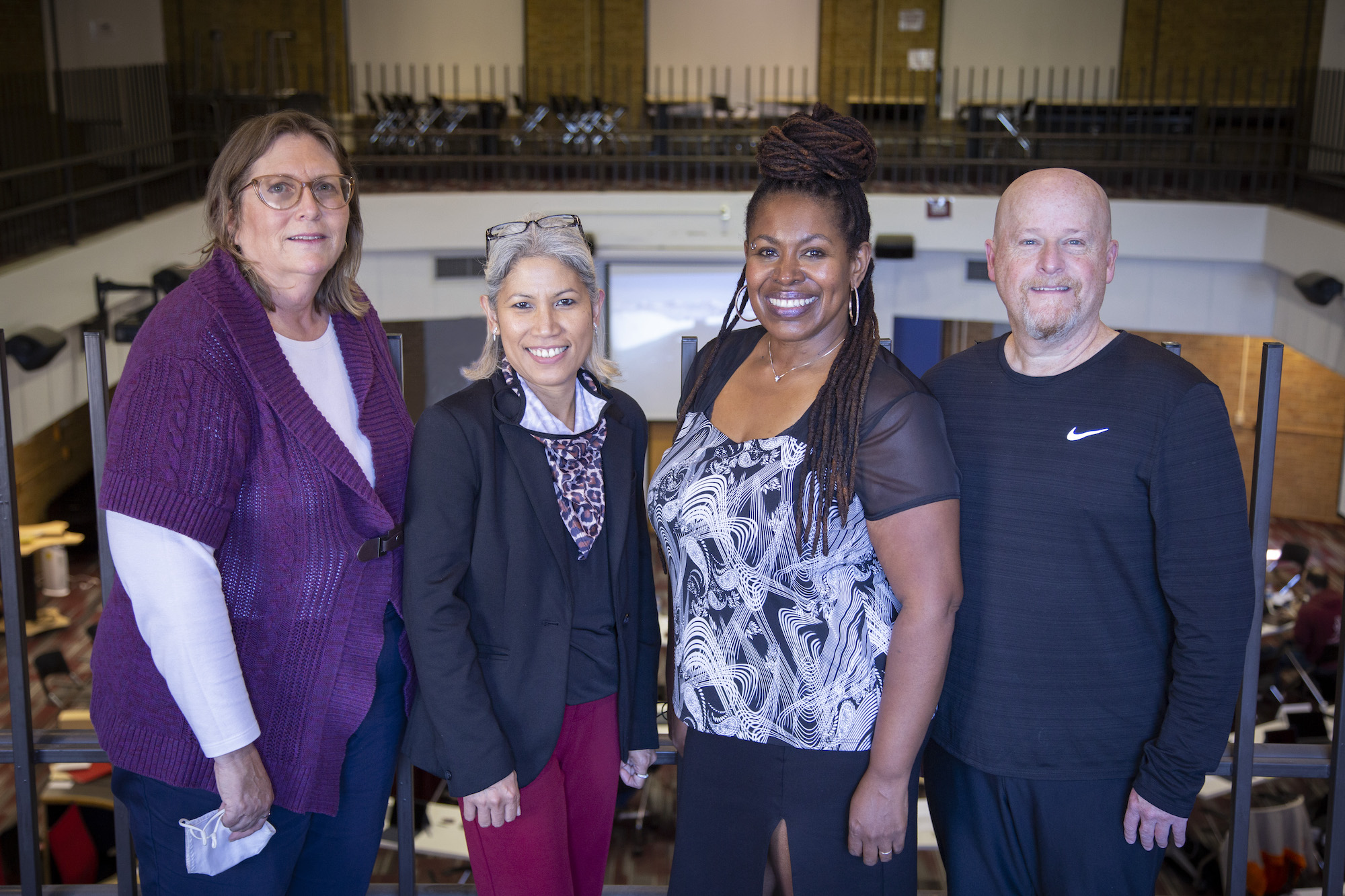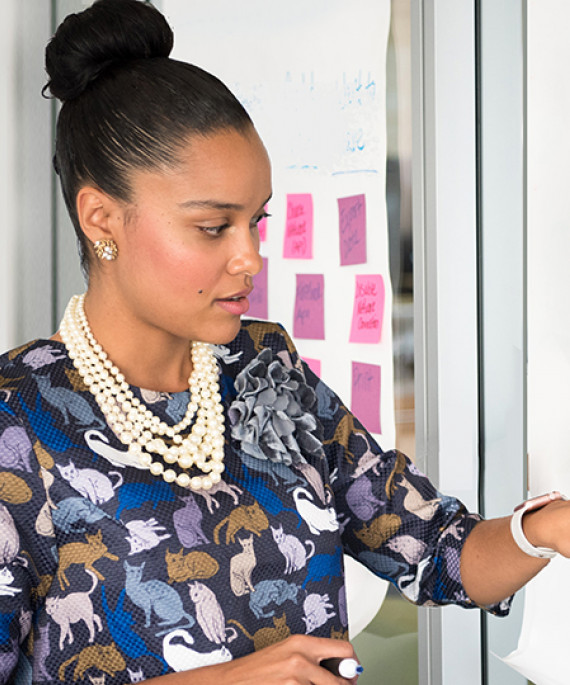
Mark Tremayne, director of innovation and extended learning at Hilliard City Schools brought colleagues to the on-boarding event of the Creative Educator Academy on Sept. 24. They are, front row, L to R: Kara Ripp, Carrie Higginbotham, Stacy Carter, Julie Fout. Back row, L to R: Tremayne, Eric Lane, Whitney Gorbett, Nikki Henkel, Jim Smalley.
Educators learn enhanced uses of technology to solve educational problems
COVID-19 upset the normalcy of education, and educators and students paid the price for the disturbance.
Tracey Stuckey, clinical associate professor of learning technologies at the college, stepped in to help with the technical problems that arose or were illuminated by the pandemic.
"We have been forced to embrace ways of [addressing] educational problems because of what COVID created," Stuckey said. "We should be building on that momentum that we have right now to continue thinking creatively."
Building on that momentum is precisely the direction she's headed. Teaching creative problem solving in education is not only a focus for Stuckey, but also for the college.
The college teamed up with Apple to deliver TransformED: The Creative Educator Academy, with Stuckey as its director. Apple is supporting creative innovation to solve problems in education during this yearlong professional learning experience.
The academy is meant to support educators, especially those at high-needs school districts, in achieving within three areas of impact:
- Transforming instructional practices in K-12 education and help educators adapt to challenging shifts in teaching and learning during the significant changes following the global COVID pandemic
- Improving ways to teach and provide student experiences in science, technology, engineering, art and mathematics (STEAM) education applications in grades 4-12 to prompt collaboration and build skills to meet shifting workforce needs and promote success in emerging industries
- Driving the use of best practices in virtual and hybrid models of teaching and learning
To meet these aims, the program is providing educators with tools, professional learning online and networking experiences over one academic year. The academy will culminate in a showcase for participants, local educators and Ohio State community members.
Thirty-one educators signed up from multiple school districts, some as part of a cohort, some as individuals. They are focusing on problems in a variety of areas, such as instructional design principles, challenge-based learning and educational risk taking and creativity.
"Fostering strong collaboration with our K-12 and industry partners is a priority for the college," said Don Pope-Davis, dean of the College of Education and Human Ecology. "Initiatives like the Creative Educator Academy allow us to break down barriers and engage educators from the university, school districts and regional organizations in the shared work of enhancing learning experiences and raising achievement for all students."
Innovative thinking leads to innovative learning

(L-R) Candy Bores, Vivian Brownlow and (far right) Chris Jones pause for a moment during the academy on-boarding session with Tracey Stuckey (second from right)
Environment impacts the way a child learns, explained Chris Jones, a business teacher and career coordinator with the Mid-Ohio Educational Service Center in Mansfield, Ohio.
Jones works with F.I.R.S.T School in the Mansfield area, funded by the Ohio Department of Education's Private Residential Treatment Facility Pilot Program. The school serves girls and young women recovering from traumatized backgrounds, so education isn't always their first priority.
Jones, along with F.I.R.S.T. School teacher Vivian Brownlow, signed up for the academy to boost his students' interest in learning. He wants to use technology in new ways for his students to track their learning progress.
"We want them to have an app to take to colleges or job sites so they can say, ‘Look where I started, and look at how much I learned,'" Jones said. "We want them to participate in the app and have it to share when they return to their home schools."
F.I.R.S.T. School also has funding from Title 1-Delinquent Funds administered by Mid-Ohio Educational Service Center, which partners to ensure an appropriate educational program.
Candy Bores, technology manager for the service center, is the tech-savvy educator who joined the academy with Jones and Brownlow to expand their knowledge to help students. "By using creative thinking and technology to track learning and success, we believe students will be more involved than if they have only a report card or a certificate," Bores said.
"If all goes well, we will work with teachers in our other districts as well, including Abraxas," a residential education center for young males, she said. "We are starting with the (academy) to come up with an innovative way to encourage these kids to be interested in their learning and see their growth."
Creativity: A critical thinking skill with lasting effects
Mark Tremayne, director of innovation and extended learning at Hilliard City Schools, the eighth largest district in Ohio, joined the academy with a cohort of 9 others. He is enthusiastic about the opportunity to enhance his district's capabilities through new uses of technology, creativity and experiential learning.
Hilliard has an Innovation Campus led by administrators trained in design thinking who collaborate with classroom teachers. Seventh through 12th grade students come to the campus to engage in customized learning experiences in their interest areas: health professions, business, teaching, science and STEAM programming.
Additionally, all K-6 buildings have Innovation and Discovery Centers with trained specialists creating hands-on, minds-on learning opportunities through an inquiry approach.
Because every student has an iPad, Tremayne saw the academy as a chance to continue to innovate with technology and creativity. "It's about personalizing learning for students," he said. "We believe that creativity is a critical thinking skill that we can leverage for our students."
The Hilliard cohort plans to achieve two goals through the academy. First, they plan to scale innovation and creativity throughout the Hilliard City School District by assembling leveled resources and lessons. The lessons will include challenge-based learning opportunities for students to solve real-world problems with new technological approaches.
For instance, Tremayne said a real-world problem could be scheduling and coordinating school transportation more effectively.
Second, the school district will develop a K-12 vision around science, technology, engineering, art and mathematics (STEAM) education in partnership with students, families, industry experts and leaders from higher education.
"We will audit our current STEAM learning programs and courses," Tremayne said, "perform a gap analysis to examine strengths, weaknesses, and opportunities and ultimately recommend new experiential learning programs and courses. Highlighting these will provide recommendations that will prepare students for the future workforce."
Tremayne knows the importance of connecting students with business, industry, higher education and all aspects of careers. "We need these partnerships; we need these connections with business and industry to know how to prepare our students to be ready for tomorrow," he said.
He sees the academy as a creative springboard to establish the optimal environment for teachers and students.
A hope for change in learning
Stuckey wants academy participants to embrace the change their learning will bring, wants them to feel free to try new approaches to benefit their students.
"Educators must feel safe to try things and fail without fear of being punished or fired. If they are too afraid to try new things, how can they practice creativity? How can they transform education?"


